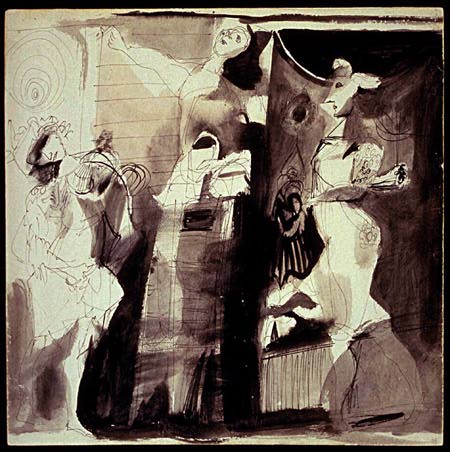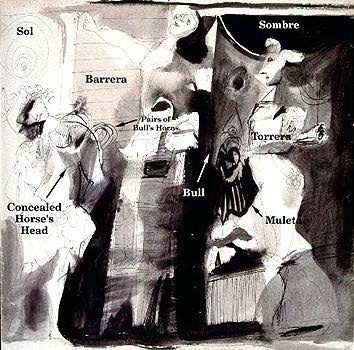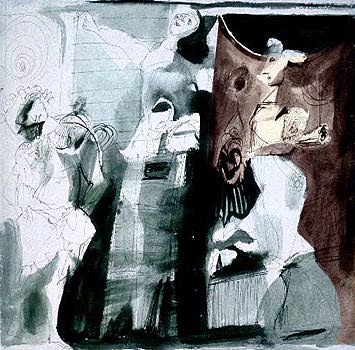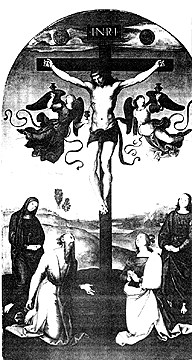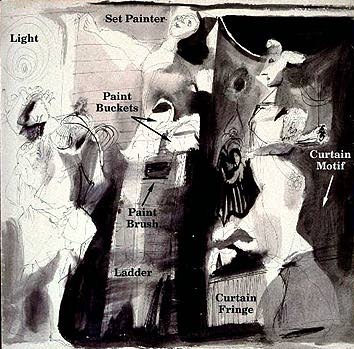Symbolism
in the 1934 Drawing
Picasso's Harlequin
Picasso's best known alter
ego is the Harlequin, a mysterious character with classical origins who has long
been associated with the god Mercury and with Alchemy and the Underworld. Harlequin's
traditional capacities to become invisible and to travel to any part of the world
and to take on other forms were said to have been gifts bestowed on him by Mercury.
It was also said that the secrets of Alchemy were to be found concealed within
the Harlequinade.
Harlequin is also a established character of Punch
and Judy theatre who in his local forms of 'Christoforo' and 'Pulchinelli', was
a popular feature of Barcelona street life at the turn of century.

Picasso undoubtedly
saw many such performances at this time, he even assisted in some of Pére
Romeu's puppet shows at Els Quatre Ghats and he would have also seen re-enactments
of Harlequin's triumph over Death in Barcelona's annual street carnivals.
Wine
was one of Harlequin's traditional accoutrements which he often used to seduce
women, occasionally Picasso's Harlequin appears to do the same thing as is alluded
to in his famous painting 'Au Lapin Agile', 1905.

Picasso's harlequin
also appears as the father of an infant or yearning for paternity, this is strongly
associated with the traditional Harlequin and his ability to breast feed his own
children which in turn is an allusion to his status as an androgyne.
Picasso
also symbolically links Harlequin's wine with pregnancy as alluded to in the 1905
drawing 'Circus Artist and Child,'depicting a mother breast feeding her child
with a wine bottle at her feet which has been adapted with a teat to become a
baby's feeding bottle.


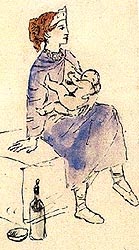
In the Three
Dancers and the 1934 drawing there is a further and quite astonishing cryptic
interlinking of this wine and pregnancy symbolism.
Picasso
also concealed a number of Harlequins in his most famous painting Guernica. These
hidden Harlequins appear to be magically undermining the forces of death in the
painting, which is reminiscent of Harlequin's traditional triumph over Death in
the Barcelona carnival.
tOP
Oedipus
According
to numerous Picasso biographies, when Picasso was about thirteen years old, his
father, a passionate amateur painter, gave him his paintbrushes and ceased painting
altogether. This appears to have taken on great psychological significance later
in Picasso's life for he equated it with patricide, a killing of his father's
creativity. The paintbrush was to become an important symbol that Picasso identified
with his own creative powers and masculinity.
Picasso recognised the
symbolic connection between this event in his early life and the Oedipus complex
of Sigmund Freud. He then adopted Oedipus as a secretive alter ego because the
story provided a wealth of symbolic associations that Picasso already identified
with in his art.
Oedipus
had been a popular theme amongst the Surrealists and others around Picasso in
the 1920's. Picasso appears to have embraced the theme at around that time, this
is apparent in a drawing he made on the subject in 1926.
In
Sophocles' play, Oedipus is exposed as a baby boy by his father, the king of Thebes.
The king did this to prevent the unfolding of a prophecy that he would die at
the hands of his son. Oedipus' feet were pieced by a piece of wood and he was
hung in a tree and left to die, but was rescued and bought up by shepherds. Picasso
already identified with Crucifixion and so the Crucifixion aspect of the story
reinforced his identification with Oedipus. Picasso's identification with Oedipus
was strengthened still further because as soon as Oedipus realises that he has
unwittingly killed his father and married his mother, he blinds himself and goes
into self imposed exile. Blindness was an important theme for Picasso, he once
stated that painting was a 'blind man's profession'. Themes of blindness emerged
early in his pictures and recurred many times. Associated with soothsaying and
prophecy, blindness had personal connotations for Picasso, for he was believed
by some of his close friends to have had the power of prophecy.
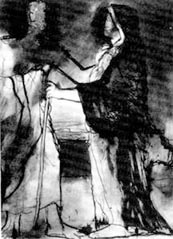
Exile was another
feature of Picasso's life that provided a symbolic link with Oedipus. From 1904
onwards, Picasso lived the life of an exile for his art. He was also a member
of the Spanish colony of Paris, many of whose members were political exiles because
of their membership of the Anarchist movement with which Picasso was also closely
linked. Then after 1936, Picasso swore not to return to Spain whilst Franco was
in power. Oedipus, despite losing his prince's
birthright eventually becomes
a king. Picasso also identified with kings, we see this in his famous signature
, 'Yo el Rey', and in a 1906 sculpted head where of harlequin as king. Christ,
the king of the Jews, was another of Picasso's alter egos. Kingship was therefore
an important feature in Picasso's choice of alter egos.
There
is a further link between Oedipus in Picasso's 1941 play, 'Desire Caught by the
Tail,' in which an artist called 'Big Foot' takes one of the leading roles. 'Big
Foot' has been closely identified with Picasso by art historians; his name appears
to have been derived from the name of Oedipus which means 'Swollen Feet,' in its
original Greek.
tOP
Wagner and Picasso
At the
turn of the century in Barcelona a number of poets and artists, including Picasso,
formed a literary group called Valhalla. Although the group's activities remain
to this day something of a mystery, it seems from the name Valhalla, that Wagner
and his operatic storytelling may have been one of their main interests.
Wagner had been very popular throughout Europe and was at this time making
an important impact on the cultural scene in Barcelona. His operas revived Norse
and Arthurian legends with underlying mystical themes that an inspiration to the
Symbolists and Modernistas with whom Picasso was associated.
Picasso's
interest in Wagner has not gone unreported; he almost certainly attended some
of the Wagner operas that were performed at his favourite haunt, Els Quatre Ghats.
The 1934 drawing
contains an important Wagnerian theme that appears to be unique in Picasso's work.
It depicts what is probably the most dramatic scene in 'Parsifal' - the moment
when the spear that once killed Christ hovers over Parsifal's head after being
hurled at him by the evil magician Klingsor.
This
passage in the opera had special symbolic significance for Picasso in 1934 because
it related closely to his personal life at that time and also to his concern about
the rise of Hitler and the threat of a second world war.
tOP
Hitler and The Spear of Destiny
Both Guernica and the 1934 drawing conceal references to a mystical battle between
Picasso and Hitler in connection with the Spear of Destiny. This hidden pictorial
narrative, set in the context of Wagner's opera Parsifal, reveals some uncanny
associations with events in Hitler's life and with his quest to dominate Europe.
Vienna 1909-1913
According to the account of Dr Walter Stein, the young Hitler whilst living
as a down and out in Vienna undertook a penetrating study of the Occult meanings
underlying Wolfram Von Eschenbach's Thirteenth Century Grail Romance, 'Parsival'.
Stein through various contacts with Hitler became convinced that he was deeply
involved with the Occult and had an experienced spiritual mentor, possibly linked
to the infamous 'Blood Lodge of Guido Von Liszt.
Hitler
later claimed in Mein Kampf, that these had been the most vital years of his life
in which he learned all he needed to know to lead the Nazi Party.
Stein
got to know Hitler because of their mutual interest in the Spear of Destiny -
a relic on display in the Hapsburg's treasury at the Hofmuseum in Vienna.
The
relic was said to have phenomenal talismanic power having once been used at the
Crucifixion to wound the side of Christ. According to legend, possession of the
Spear would bring its owner the power to conquer the world, but losing it would
bring immediate death. The relic had been owned by a succession of powerful European
rulers down through the centuries and eventually came to be in the possession
of the Hapsberg Dynasty.
Hitler
confided to Stein that the first time he saw the Spear he had witnessed extraordinary
visions of his own destiny unfolding before him.
In
1923, on his deathbed, Hitler's mentor Dietrich Eckart, a dedicated Satanist and
central figure in the Occult Thule Society and a founder member of the Nazi party,
said:
'Follow
Hitler ! He will dance, but it is I who have called the tune !'
'I have
initiated him into the 'Secret Doctrine', opened his centres in vision and given
him the means to communicate with the Powers.'
'Do
not mourn for me: I shall have influenced history more than any other German.'
On
12th March 1938, the day Hitler annexed Austria, he arrived in Vienna a conquering
hero. He first port of call was to the Hofmuseum where he took possession of the
Spear which he immediately sent to Nuremberg, the spiritual capital of Nazi Germany.
At 2.10 on 30th
April, 1945, during the final days of the war, after considerable bombing of Nuremberg,
the Spear fell into the hands of the American 7th Army under General Patton. Later
that day, in fulfilment of the legend, Hitler committed suicide.
tOP
Parsifal
Wagner's
opera Parsifal features prominently in the 1934 drawing, it was originally based
on Wolfram Von Eschenbach's thirteenth century Grail romance, Parsival.
Picasso knew Wagner's version of the story and identified himself with Parsifal.
In the 1934 drawing, at the age of 52, he reveals, albeit secretly, the extent
of this symbolic identification.
It
has been well reported that the letters of Picasso's name had magical significance
for him. The first four, Pica, means spear in Spanish; which would certainly be
one reason why Picasso might identify with Parsifal in Wagner's opera. Picasso
would have realised a further significant link in the final stages of the opera.
In the second act, Parsifal begins to suffer the pain of Christ's wound in the
process of a mystical identification with Christ. By 1934, Picasso had long identified
himself with Christ and the Crucifixion in his art and the wound was already one
of his personal symbols for suffering and yearning for its resolve.
The
Spear that had once wounded the side of Christ is pivotal in Wagner's story. Klingsor,
a powerful black magician steals it and with it wounds Amfortas, the King of the
Guardians of The Holy Grail. He then flees with the Spear to his castle where
he dominates the surrounding area using powerful black magic. All this while,
Amfortas is destined to lay in agony from the wound which never heals; his only
hope of recovery being the Spear's return.
Parsifal,
an heroic fool, is prophesied to return the Spear and heal Amfortas. In an effort
to prevent the prophecy coming true, Klingsor uses magic to lure the hero to his
Castle where his men are hiding in ambush. Parsifal overcomes Klingsor's men but
suddenly Klingsor appears on the castle ramparts and in a final attempt at the
hero's destruction, he utters the following words:
Halt,
I have the right weapon to to fell you ! The fool
shall fall to me through
his master's Spear.
Klingsor hurls the Spear, but as if stopped by
the hand of God, it hovers motionless above Parsifal's head. Parsifal reaches
up and grasps the Spear and with it makes the Sign of the Cross, saying these
words:
With
this sign I rout your enchantment,
As the Spear closes the wound which you
dealt him with it
may it crush your lying splendour,
into mourning and
ruin.
Klingsor and his Castle then sink into the sea as if hit by
an earthquake, and the gardens that once surrounded the castle turn into a wasteland.
Parsifal restores the Spear and heals Amfortas of his wound. He then
becomes anointed as the new King of the Guardians of The Holy Grail.
In
the 1934 drawing this pivotal scene is portrayed by the spear hovering above Picasso's
head. The spear runs along the top edge of the drawing and when the image is rotated
90 degrees to the left it forms the shaft of a huge letter 'P" in conjunction
with the black semi-circle in the upper right corner. The 'P' denotes a cryptic
Picasso signature and refers to the artist's identifications with 'Pica' and Parsifal.
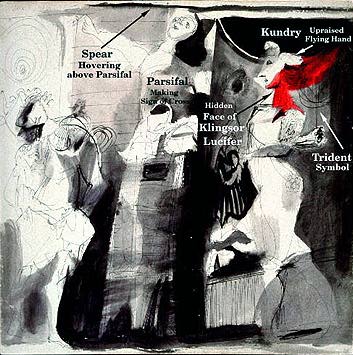
The
central figure is identifiable with Parsifal reaching up and making the Sign of
the Cross.
His
'flying hand' concealed within the island of light in the right hand figure's
face can be seen to be blocking Klingsor's advance, it is located immediately
to the left of Klingsor's face which in turn seems to descend from the rear end
of the spear in the upper right corner.

The figure on
the right would seem to characterise Kundry, the witch who was present at Christ's
Crucifixion and who under Klingsor's spell attempts to seduce Parsifal. In the
drawing she appears possessed by Lucifer or the Devil, both of whom are appropriate
characterisations of Klingsor.
Behind
the hidden face there is a trident form, which seems to reinforce the hidden face's
connection with Lucifer.
According
to Dr Walter Stein and others, Hitler was convinced that in the ninth century
he had been incarnated as the historical Klingsor, sometimes known as Landulf
II of Capua !
Stein
had been a acquaintance of Hitler in the years preceding World War One and claimed
that Hitler had at that time undertaken a penetrating study of Von Eschenbach's
story and fathomed it's deepest occult meanings.
The
self identification of Picasso with Parsifal and the self-identification of Hitler
with Klingsor appears by some uncanny means to have found its way into the 1934
drawing which might indicate that Picasso had access to secretive information
about Hitler and his occult activities at least five years before the Second World
War.
tOP
Frankenstein
In 1931,
Universal Studios released the movie Frankenstein, in which the monster
as most of us recognise him today
made his first appearance. The 1934 drawing
appears to contain an inverted double portrait of Frankenstein's monster
derived from this movie.

Picasso,
who was often described as a monster, loved the cinema and probably saw the 1931
'Frankenstein' soon after its release in France. It appears clear from the drawing
that he went on to identify a number of symbolic associations between himself
and the monster and identified other symbolic associations between the monster
and Hitler's Aryan Superman.
Frankenstein's
monster, like Oedipus and Picasso, were all in a sense responsible for the destruction
of their fathers*. All three also suffered a form of blindness; Picasso symbolically,
Oedipus by self infliction and Frankenstein's monster because at first his eyes
were too sensitive to light.
All
three also underwent a form of crucifixion; Picasso symbolically, Oedipus when
he is exposed by his father, the monster when he is created as well as when he
dies under the sign of a burning cross. Finally, all three also experienced a
form of exile; Picasso at the turn of the century in Paris and again in the 1930's
as a protest against Franco, Oedipus by his own edict and the monster by being
violently ostracised from the day of his creation.

The Hanged Man
symbol with which Picasso closely associated also features in the movie when parts
of a dead body are stolen from a gallows to be used for the creation of the monster.
A further association
involves the monster's huge feet which Picasso would have related to the 'Swollen
Feet' of his alter ego Oedipus and later with the artist 'Big Foot' in his play
'Desire Caught by the Tail.'
The
only real human contact the monster makes is with a little girl called Maria who
picks some flowers and offers one to the monster. The flower girl is another important
Picasso theme. In the movie, after the monster inadvertent kills her, the flower
girl makes an important reappearance in the guise of Dr Frankenstein's bride holding
a wedding bouquet.

The concealed,
inverted portrait of the monster in the 1934 drawing appears to have its right
eye hanging out, which is a detail that seems to link him symbolically with Odin
who had to pull out one of his eyes and hang inverted from a tree. The monster's
one good eye, by association, can be seen as a reference to the third eye.
In
regard to the 1934 drawing's concentration of Germanic themes, it would seem that
the Frankenstein image is linked with the theme of Hitler and the Third Reich.
According to
Rauschning Hitler often talked about the Aryan Superman having a Cyclops eye.
'Some men
can already activate their pineal glands to give a limited vision into the secrets
of time...but the new type of man will be equipped for such vision in the same
manner as we now see with our physical eyes', Hitler said.
He also
believed that the Supermen would be in our midst in a short time. They would have
superhuman strength and powers and nothing would be hidden from their vision and
no power on Earth would prevail against them. 'They would be the Sons of the Gods,'
he said.
Picasso
would have certainly known about Neitzsche's Superman from whom Hitler's concept
of the 'new man' was partially derived, he also appears to have known it was Hitler's
intention to create such a monster who in the drawing he relates to Frankenstein's
monster because he is a similar type of man made man, a criminal who is more dead
than alive, a creature of hell and destruction. This association seems to be all
the more appropriate because hidden within the face
of the monster in the
drawing, there appears to be an amorphous portrait of Hitler.
The
drawing also contains other apparent references to the Third Reich, an SS symbol,
a concentration of related Germanic and occult themes and perhaps the suggestion
in the drawing that the dominant force (Nazi Germany) on the right is making a
brutal attack on the helpless victim (Europe) on the left.
The
1934 drawing contains an astonishing interrelationship of themes pertaining to
Picasso, Christ, Hitler, Odin, Oedipus, Frankenstein's monster and to the flower
girls who feature in a number of early Picasso pictures and significantly, also
in Wagner's opera Parsifal.
*
The death of Dr Frankenstein is alluded to but left somewhat ambiguous at the
end of the movie, presumably in order to have a happy ending.
tOP
A Hidden Picasso Bestiary
Picasso
loved animals and they often made an appearance in his work. In 1937, he began
illustrating a special limited edition of Buffon's celebrated 'Histoire naturelle,'
for his dealer Ambroise Vollard. The book included 31 etchings of animals, birds
and insects.
Similarly, 1934 drawing contains many animal forms, including:
bulls, fishes,
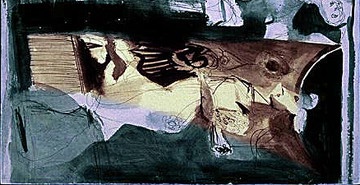
owls,
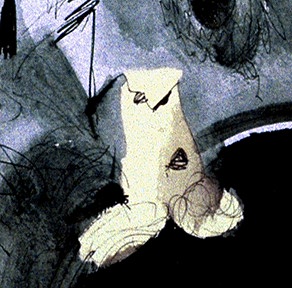
a
horse, a spider,
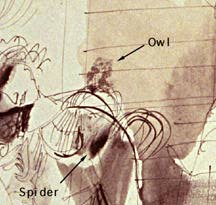
a snail,

a
wolf, an exotic bird and a sphinx-like dog.
All
these animal forms are cleverly concealed and appear to relate to the drawing's
central theme of death.
tOP
Alchemical
Contexts
Alchemical
Images
The Symbolists
and the Surrealists, with whom Picasso's art was intimately associated, sourced
a great many of their ideas from Alchemy and Magic. Picasso's art was likewise
indebted to this mystical tradition.
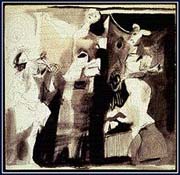
The 1934 drawing is replete with alchemical symbolism and was made for a
specific purpose at the zenith of the artist's creative life. Because of this
and the fact that Picasso's symbols tend to be universal, the drawing appears
to contain a message that seems to challenge our materialist attitude towards
the world and which has the ability to plunge us into the magical living world
of symbols.
Alchemy
is associated with a variety of dispersed belief systems, some of which are thousands
of years old. The Tao, the Mithraic cult, the Isis cult, Gnosticism, the Kabbala,
Astrology and the Tarot are a few of its sources of occult wisdom. Some of the
pagan religions of Europe were much influenced by the Eastern mystical cults that
the Romans had popularised throughout their Empire. With the rise of the Christianity,
such religions were purged from everyday life and became heresies that could only
be practiced in secrecy. At the time of the Crusades between the 11th and 14th
centuries, Europeans made contact with the culture and mysticism of the East and
bought back to Europe a wealth of Eastern occult understanding which was to have
a further influence on the pagan and other traditions at the bedrock of Western
alchemy.
Alchemy
is concerned with the transformation of the individual into an enlightened being,
hence the well known metaphor of turning base metal into gold. It uses a language
of symbols and laws many of which were known in the ancient world. It's practice
involves an initiation from where the initiate passes stages of understanding
and development toward the ultimate goal, which is sometimes symbolised by a star.
The drawing seems
to be an alchemical treatise that serves on the one hand to clarify the nature
of man's dilemma in a dualistic and seemingly chaotic world and on the other,
poetically express all the forces and concerns acting on the artist's life at
the time.


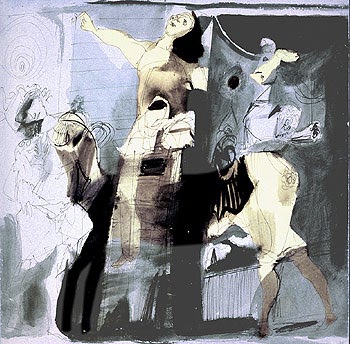
tOP
Mirror
Images
The 1934 drawing
contains two extraordinary mirror images that can be seen by placing a mirror
vertically down the centre of the composition. The right hand side reveals a bull-like
horned demon flanked by two guardians

and
the left hand side reveals a terrifying apocalyptic crucifixion.
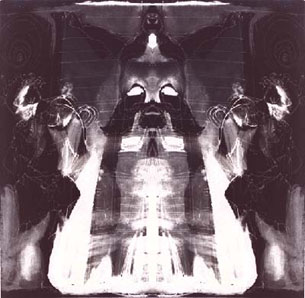
The use of willow wands,
wax dolls, water divining and magic mirrors are well known features of Tao magic
which happens to be closely related to European sorcery. Taoist magical practices
were bought to Europe centuries ago by Arabs trading with China. Taoist magicians
would often possess a magical mirror which he would use to compel his demon to
appear to him in his true shape, once this was accomplished the magician would
be freed from the demon's power.
This
freeing from the demon's power appears to have been Picasso's magical intention
in incorporating such images into the drawing. It is especially relevant in the
context of Picasso's own overpowering feelings of crucifixion and melancholy in
1934 and to his vision of the European apocalypse that was to be bought about
by Hitler.
The
images are shown in negative for added impact.
tOP
Melencolia
In
the year 1514 the German painter and engraver Albrect Dürer made his most
famous engraving, 'Melencolia'.
The engraving is an allegory describing
the creative melancholy of the artist and is thought to be a symbolic self portrait.
Dürer's Melencolia is replete with alchemical symbolism related directly
to much of the symbolism in the 1934 drawing.
Picasso
was a great admirer of Dürer and owned at least one original print by the
artist, given to him by Max Jacob; he also owned a an expensive German edition
of reproductions of Dürer's work.
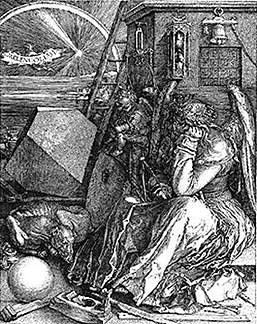
Dürer's
theme of Saturnalian Melancholy appears to have been derived from a treatise by
a German physician named Heinrich von Nettesham, written around 1510, and entitled
'De occulta philosophia.'
Since
classical times artistic Melencolia was thought of as a depressed state of mind
that takes away an artist's enthusiasm for his work. It's cure was believed by
Renaissance astrologer's to be aided by the charm of a magic square and in particular
the Jupiter magic square which appears in the upper right hand corner of Dürer's
engraving. The square is magic because each row, each column and each diagonal,
add up to the same number, which in the Jupiter magic square is 34. The numerals
3 and 4 also denote special importance in Alchemy because they represent the spiritual
transformation of the alchemist. 3 symbolises the limited, finite life of the
physical world and everyday existence and 4 symbolises the infinite realm of the
spirit and the cosmos. Their product is 12, the number of Tarot card the Hanged
Man, which in turn symbolises the union of physical life and spiritual life.

The
number 34 is relevant to the drawing because it refers the year it was made and
to its predominant theme of Crucifixion because of its association to the symbolism
of the Hanged Man in the Tarot.
In
Melencolia, Dürer has incorporated the engraving's date, 1514, into the lower
row of numbers in the magic square.

In a similar
way Picasso hid the date of production into the 1934 drawing. The digits '34'
appear in many places within the black ink of the composition, but are only made
visible after computer enhancement.
The
square format of the drawing is rare in Picasso's work, and in this case, it appears
to signify that the drawing is itself a magic square, intended to charm off the
melancholy that was beginning to affect Picasso's life at the time.
The 1934 drawing contains a number of other esoteric elements which appear to
have been borrowed from Dürer's Melencolia. In both compositions for example,
there is a concealed squaring of a circle. In the lower left corner of Dürer's
work there is a circle in the form of a globe, in the upper left corner there
is a semi-circle in the form of a rainbow, and in the upper right there is a quarter
circle defined by a bell rope and in the lower right corner the circle disappears
altogether, thereby breaking the sequence. This is a circle being halved systematically
through three corners of the frame of the composition and finally disappearing.
In the 1934 drawing, we find the same process taking place. In the upper left
corner, there is a circle in the form of the spiral motif, in the upper right
corner, there is a semi circle in the form of a black half moon, and in the lower
right corner, there is a quarter circle painted in wash, finally in the lower
left corner all traces of the circle disappear, again breaking the sequence. The
symbolism indicates liberation or transcendence from melancholy and it is also
strongly indicative of
death and resurrection.
The
two pictures also contain very similar iconography, in each there is a dog, a
ladder, two angels, the tools of the artist's trade: paints and a brush in the
Picasso and woodworking tools in the Dürer. All this leaves little doubt
that Dürer's greatest engraving was an important source in the creation of
the 1934 drawing.
tOP
Erik
Satie
Along
the right hand edge of the drawing there is a concealed image of a dog like creature
associated with Anubis, one of the Egyptian gods of the underworld.
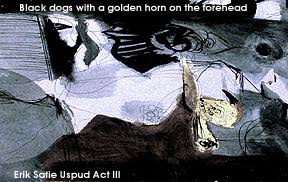
This
sTRANGE animal form also appears to be strongly connected with Erik Satie's 1892
ballet 'Uspud'. Satie was a Rosicrucian and had been a great friend of Picasso,
who was said by Picasso, to have been one of the most important influences in
his life. The two had worked together on Jean Cocteau's 'Parade' in 1917, and
they had a strong mutual interest in Alchemy and the Occult.
Uspud
is a deeply mystical and satirical work; it is short and full of strange imagery,
like the 1934 drawing, it unfolds around the theme of the Crucifixion. In the
final act, there is a description that strongly resembles the image of Anubis
in the drawing. There is a further description of fishes with the heads and wings
of a bird which appears to be represented pictorially in the same part of the
drawing.
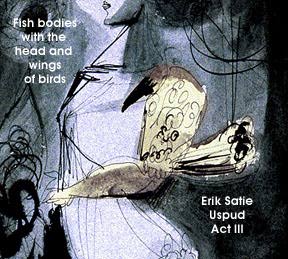
Uspud Act III
The top of a mountain:
a crucifix above.
Uspud,
clad in homespun garments. prostrates himself before the crucifix: for a long
time he prays and weeps.
When
he raises his head, Christ unfastens his right arm from the cross, blesses Uspud
and disappears. The holy spirit penetrates Uspud.
Procession
of male and female saints: saint Cleopheme spits his teeth into his hand: saint
Micanar bears his eves on a platter the blessed Marcomir has his legs burnt to
a cinder: saint Iduciomare's body is pierced with arrows, saint Chassebaigre,
confessor, in violet robes: saint Lumore with a sword; saint Gebu with redhot
irons; saint Glunde with a wheel: saint Krenou with a sheep; saint Japuis, with
doves escaping from a cleft in his forehead: saint Umbeuse spinning wool: the
blessed Melou the lame: saint Vequin the flayed: saint Purine the unshod: saint
Plan, preaching friar: saint Lenu with a hatchet. Their voices summon Uspud to
martyrdom. He is penetrated by an unquenchable thirst for suffering. He tears
off his homespun robes and appears clad in the white tunic of neophytes. He prays
again. A swarm of demons rise up on all sides. They assume monstrous forms: black
dogs with a golden horn on the forehead; fish bodies with the head and wings of
birds: giants with bulls heads. snorting fire through their nostrils. Uspud commends
his soul to the lord, then gives himself up to the demons who tear him to pieces
in a fury. The Christian church appears radiant with light and escorted by two
angels bearing palm leaves and crowns. She takes Uspud's soul in her arms and
raises him up towards Christ, who is resplendent in heaven. End.
Apart
from the two similarities in imagery with that in the 1934 drawing, Picasso seems
to have used Uspud as a source for a series of 1959 crucifixion sketches related
to the bullfight. They depict Christ crucified in a bullring, detaching his right
arm from the cross, just as described in act III.
tOP
Isis
The
female figure on the right of the drawing appears to represent Isis wearing her
traditional moon headdress and in the company of the god Anubis her jackel headed
companion.

Isis represents
different aspects of the feminine archetype, in ancient Egypt, she was the mother
goddess and the queen of the underworld. In Egyptian art she was often depicted
in the presence of her underworld companion Anubis, who conveyed the souls of
the dead for judgment.
In
the Roman Empire, the cult of Isis was very popular throughout the Mediterranean
area. It focused on the celebration of the mysteries of the death and the resurrection
of Osiris. Isis, had been the consort of Osiris, and after his murder she recovered
the scattered parts of his body and restored them to life. Osiris then became
king of the dead and his son Horus became king of the living. The story of Isis,
Osiris and Horus parallels the Christian mysteries of the virgin birth
and
the resurrection. It is also the origin of certain the Christian symbol of the
Madonna and Child.
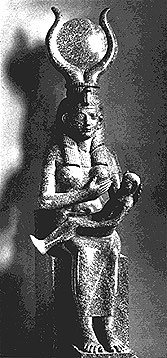
The cult of Isis
continued to be practised throughout the former Roman Empire right up to the sixth
century AD when it was finally driven underground by Christianity. Isis lived
on within certain esoteric traditions throughout the middle ages and continues
to be an important part of the Alchemical tradition, which is almost certainly
why she is represented in the 1934 drawing.
tOP
The Mithraic Cult
Picasso's
use of the bullfight theme appears to have an association with the Mithraic cult.
The American art historian Ruth Kaufman identified the use of Mithraic iconography
in Picasso's Crucifixion of 1930 and associated it with the writings of Georges
Bataille who was Picasso's friend at that time.
Picasso also seems to
have referred to the Mithraic cult in his work before 1930. In 1901, he made a
series of studies and paintings of women at the infirmary of Saint Lazare, in
which the subjects are often wearing a Mithraic cap, a kind of bonnet traditionally
worn by Mithras and associated with alchemy. The patients at Saint Lazare wore
a similar type of headgear; Picasso's exaggerated rendition of it has been linked
to the Phrygian cap - the Mithraic cap by another name,
which later became
a symbol of the French revolution.
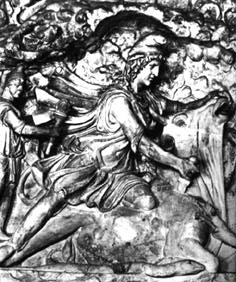
The Mithraic
cult was early Christianity's most serious rival as it spread from Syria, Anatolia
and Phrygia throughout the Roman Empire. Its origins are obscure but it was known
to have been one of the religions of ancient Indo-Persia. The earliest record
of the cult dates as far back as 1400 B.C. The cult was a form of sun worship
involving astrology. Its was symbolically represented by the god Mithras and the
eternal struggle between good and evil. It was an exclusive male cult with seven
grades of initiation, symbolized by a seven runged ladder which was believed to
lead to immortality. Most important in the stages of initiation was the slaying
of the bull, a re-enactment of Mithras' killing of the cosmic bull of creation,
symbolising the conquest of evil and death. The Mithraic cap represented freedom
from materialism and another of its symbols, the Tau cross, signified the uniting
of opposites. The cult was introduced to the West in the 1st century AD by the
Romans and it became very popular among the military and the merchant classes.
By the 4th century, it became the target of Christian persecution and gradually
died out, but its legacy continued to live on in the more secretive practices
of Alchemy. Symbolic facets of the legacy also found their way into Christianity,
Mithras' birth was celebrated on the 25th of December, and cakes marked with a
cross, representing the Earth, were traditionally eaten at the cult meal.
The
1934 drawing is full of Mithraic symbolism derived from the traditions of alchemy
and the artists knowledge of ancient culture and symbolism. The theme of the bullfight
is partly a Mithraic theme. Picasso's use of the seven runged ladder and the Tau
cross in the drawing appear to be derived from the same source, as are a number
of other more obsure symbols. The symbolism of Mithraism was extensive and parts
of it correspond astonishingly with other esoteric disciplines including the Kabbala
and the Tarot.
tOP
The Hanged Man
Picasso
was very conversant with the Tarot and seems to have identified closely with the
card known as the Hanged Man. It depicts a man with his hands tied behind his
back hanging by one of his feet from a gibbet placed between two trees.

Though interpretations
of the card vary it is generally believed to symbolise a self-sacrifice in which
the subject undergoes an important transformation from a materialistic consciousness
to a spiritual consciousness.
The
Hanged Man is in a state of solitude and submission to divine will, he hangs suspended
between the forces of heaven and earth and his sacrifice brings him mystical knowledge
and redemption.
The
card corresponds astrologically with the sign of Scorpio, Picasso's birth sign,
and its number is 12 which is related to inspiration and personal development.
The central figure
in Picasso's Three Dancers features the outstretched arms of a traditional Crucifixion
in combination with the crossed legs of the Hanged Man.
In
the 1934 drawing, whose composition is heavily derived from The Three Dancers,
the central figure has one leg raised above the other upon the steps of a ladder.
If imagined from
the side, the figure's legs would have the same crossed appearance as the legs
of the Hanged Man and those of the central figure in The Three Dancers.

This
reveals a cryptic identification between the Hanged Man and the central figure
in the 1934 drawing, who in turn is identifiable with Picasso.
The
origin of the Hanged Man is said to be connected with the sacrifice of Odin, the
chief of the Norse gods, who according to mythology, hung upside down in a tree
for nine days to gain entry to the underworld and learn the meaning of the runes.
As a precondition to his self sacrifice Odin was wounded with his own spear and
had to pull out one of his eyes.
Picasso
would have doubtless identified with the Odinic sacrifice and realised its obvious
symbolic connections with Christ's crucifixion and with the 'crucified' exposure
and self inflicted blindness of Oedipus.
Odin
according to myth, finally meets his end in a terrible apocalypse in which the
universe is destroyed. The theme of the Odinic apocalypse, called Ragnorok, would
have been well known to Picasso, not only because of his insatiable appetite for
legends and myths, but also because it featured in the final act of Gotterdammerung,
the Twilight of the Gods, the final part of Wagner's famous most famous operatic
work, The Ring Cycle. In Wagner's version of the story, it
is Odin who brings
about Ragnorok because of his pride. Wagner signifies Ragnorok by the breaking
of Odin's spear, the symbol of his power which equates symbolically with the spear
in Parsifal and also with Picasso's name.
Another
important symbolic association between Odin and Picasso is that Odin's counterpart
in the Southern pantheon is the god Hermes or Mercury. Picasso had been closely
identified with Hermes from an early date, his friend Guillaume Apollinaire, openly
referred to him as the Harlequin Trimegistus, a derived name of Hermes Trimegistus,
Hermes the Thrice Great, the god of Alchemy.
tOP
Interpretations
of the 1934 Drawing
This
section contains a number of scholars' interpretations of Picasso's work and the
1934 drawing.
Jung's
1932 Article on Picasso
"As
a psychiatrist, I almost feel like apologising to the reader for becoming involved
in the excitement over Picasso. Had it not been suggested to me from an authoritative
quarter, I should probably never have taken up my pen on the subject. It is not
that this painter and his strange art seem to me too slight a theme - I have,
after all, seriously concerned myself with his literary brother, James Joyce.
On the contrary, his problem has my undivided interest, only it appears too wide,
too difficult, and too involved for me to hope that I could come anywhere near
to covering it fully in a short article. If I venture to voice an opinion on the
subject at all, it is with the express reservation that I have nothing to say
on the question of Picasso's 'art' but only on its psychology. I shall therefore
leave the aesthetic problem to the art critics, and shall restrict myself to the
psychology underlying this kind of artistic creativeness.
For almost twenty
years, I have occupied myself with the psychology of the pictorial representation
of psychic processes, and I am therefore in a position to look at Picasso's pictures
from a professional point of view. On the basis of my experience, I can assure
the reader that Picasso's psychic problems, so far as they find expression in
his work, are strictly analogous to those of my patients. Unfortunately, I cannot
offer proof on this point, as the comparative material is known only to a few
specialists. My further observations will therefore appear unsupported, and require
the reader's good will and imagination.
Non-objective
art draws its contents essentially from 'inside.' This 'inside' cannot correspond
to consciousness, since consciousness contains images of objects as they are generally
seen, and whose appearance must therefore necessarily conform to general expectations.
Picasso's object, however, appears different from what is generally expected -
so different that it no longer seems to refer to any object of outer experience
at all. Taken chronologically, his works show a growing tendency to withdraw from
the empirical objects, and an increase in those elements which do not correspond
to any outer experience but come from an 'inside' situated behind consciousness
- or at least behind that consciousness which, like a universal organ of perception
set over and above the five senses, is orientated towards the outer world. Behind
consciousness there lies not the absolute void but the unconscious psyche, which
affects consciousness from behind and from inside, just as much as the outer world
affects it from in front and from outside. Hence those pictorial elements which
do not correspond to any 'outside' must originate from 'inside.'
As
this 'inside' is invisible and cannot be imagined, even though it can affect consciousness
in the most pronounced manner, I induce those of my patients who suffer mainly
from the effects of this 'inside' to set them down in pictorial form as best they
can. The aim of this method of expression is to make the unconscious contents
accessible and so bring them closer to the patient's understanding. The therapeutic
effect of this is to prevent a dangerous splitting-off of the unconscious processes
from consciousness. In contrast to objective or 'conscious' representations, all
pictorial representations of processes and effects in the psychic background are
symbolic. They point, in a rough and approximate way, to a meaning that for the
time being is unknown. It is, accordingly, altogether impossible to determine
anything with any degree of certainty in a single, isolated instance. One only
has the feeling of strangeness and of a confusing, incomprehensible jumble. One
does not know what is actually meant or what is being represented. The possibility
of understanding comes only from a comparative study of many such pictures. Because
of their lack of artistic imagination, the pictures of patients are generally
clearer and simpler, and therefore easier to understand, than those of modern
artists.
Among
patients, two groups may be distinguished: the neurotics and the schizophrenics.
The first group produces pictures of a synthetic character, with a pervasive and
unified feeling. When they are completely abstract, and therefore lacking the
element of feeling, they are at least definitely symmetrical or convey an unmistakable
meaning. The second group, on the other hand, produces pictures which immediately
reveal their alienation from feeling. At any rate they communicate no unified,
harmonious feeling-tone but, rather, contradictory feelings or even a complete
lack of feeling. From a purely formal point of view, the main characteristic is
one of fragmentation, which expresses itself in the so called 'lines of fracture'
- that is, a series of psychic 'faults' (in the geological sense) which run right
through the picture. The picture leaves one cold, or disturbs one by its paradoxical,
unfeeling, and grotesque unconcern for the beholder. This is the group to which
Picasso belongs*.
In
spite of the obvious differences between the two groups, their productions have
one thing in common: their symbolic content. In both cases the meaning is an implied
one, but the neurotic searches for the meaning and for the feeling that corresponds
to it, and takes pains to communicate it to the beholder. The schizophrenic hardly
ever shows any such inclination; rather, it seems as though he were the victim
or this meaning. It is as though he had been overwhelmed and swallowed up by it,
and had been dissolved into all those elements which the neurotic at least tries
to master. What I said about Joyce holds good for schizophrenic forms of expression
too: nothing comes to meet the beholder, everything turns away from him; even
an occasional touch of beauty seems only like an inexcusable delay in withdrawal.
It is the ugly, the sick, the grotesque, the incomprehensible, the banal that
are sought out - not for the purpose of expressing anything, but only in order
to obscure; an obscurity, however, which has nothing to conceal, but spreads like
a cold fog over desolate moors; the whole thing quite pointless, like a spectacle
that can do without a spectator.
With
the first group, one can divine what they are trying to express; with the second,
what they are unable to express. In both cases, the content is full of secret
meaning. A series of images of either kind, whether in drawn or written form,
begins as a rule w with the symbol of the Nekyia - the journey to Hades, the descent
into the unconscious, and the leave-taking from the upper world. What happens
afterwards, though it may still be expressed in the forms and figures of the day-world,
gives intimations of a hidden meaning and is therefore symbolic in character.
Thus Picasso starts with the still objective pictures of the Blue Period - the
blue of night, of moonlight and water, the Tuat-blue of the Egyptian underworld.
He dies, and his soul rides on horseback into the beyond. The day-life clings
to him, and a woman with a child steps up to him warningly. As the day is woman
to him, so is the night; psychologically speaking, they are the light and the
dark soul (anima). The dark one sits waiting, expecting him in the blue twilight,
and stirring up morbid presentiments. With the change of colour, we enter the
underworld. The world of objects is deathstruck, as the horrifying masterpiece
of the syphilitic, tubercular, adolescent prostitute makes plain. The motif of
the prostitute begins with the entry into the beyond, where he, as a departed
soul, encounters a number of others of his kind. When I say 'he,' I mean that
personality in Picasso which suffers the underworld fate - the man in him who
does not turn towards the day-world, but is fatefully drawn into the dark; who
follows not the accepted ideals of goodness and beauty, but the demoniacal attraction
of ugliness and evil. It is these antichristian and Luciferian forces that well
up in modern man and engender an all-pervading sense of doom, veiling the bright
world of day with the mists of Hades, infecting it with deadly decay, and finally,
like an earthquake, dissolving it into fragments, fractures, discarded remnants,
debris, shreds, and disorganised units. Picasso and his exhibition are a sign
of the times, just as much as the twenty-eight thousand people who came to look
at his pictures.
When
such a fate befalls a man who belongs to the neurotic, he usually encounters the
unconscious in the form of the 'Dark One,' a Kundry of horribly grotesque, primeval
ugliness or else of infernal beauty. In Faust's metamorphosis, Gretchen, Helen,
Mary, and the abstract 'Eternal Feminine' correspond to the four female figures
of the Gnostic underworld, Eve, Helen, Mary, and Sophia. And just as Faust is
embroiled in murderous happenings and reappears in changed form, so Picasso changes
shape and reappears in the underworld form of the tragic Harlequin - a motif that
runs through numerous paintings. It may be remarked in passing that Harlequin
is an ancient chthonic god.
The
descent into ancient times has been associated ever since Homer's day with the
Nekyia. Faust turns back to the crazy primitive world of the witches' sabbath
and to a chimerical vision of classical antiquity. Picasso conjures up crude,
earthy shapes, grotesque and primitive, and resurrects the soullessness of ancient
Pompeii in a cold, glittering light - even Giulio Romano could not have done worse!
Seldom or never have I had a patient who did not go back to neolithic art forms
or revel in evocations of Dionysian orgies. Harlequin wanders like Faust through
all these forms, though sometimes nothing betrays his presence but his wine, his
lute, or the bright lozenges of his jester's costume. And what does he learn on
his wild journey through man's millennial history? What quintessence will he distil
from this accumulation of rubbish and decay, from these half-born or aborted possibilities
of form and colour? What symbol will appear as the final cause and meaning of
all this. In view of the dazzling versatility of Picasso, one hardly dares to
hazard a guess, so for the present I l would rather speak of what I have found
in my patients' material. The Nekyia is no aimless and purely destructive fall
into the abyss, but a meaningful katabasis eis antron, a descent into the cave
of initiation and secret knowledge. The journey through the psychic history of
mankind has as its object the restoration of the whole man, by awakening the memories
in the blood. The descent to the Mothers enabled Faust to raise up the sinfully
whole human being - Paris united with Helen - that homo totus who was forgotten
when contemporary man lost himself in one-sidedness. It is he who at all times
of upheaval has caused the tremor of the upper world, and always will. This man
stands opposed to the man of the present, because he is the one who ever is as
he was, whereas the other is what he is only for the moment. With my patients,
accordingly, the katabasis and katalysis are followed by a recognition of the
bipolarity of human nature and of the necessity of conflicting pairs of opposites.
After the symbols of madness experienced during the period of disintegration there
follow images which represent the coming together of the opposites: light/dark,
above/below, white/black, male/female, etc. In Picasso's latest paintings, the
motif of the union of opposites is seen very clearly in their direct juxtaposition.
One painting (although traversed by numerous lines of fracture) even contains
the conjunction of the light and dark anima. The strident, uncompromising, even
brutal colours of the latest period reflect the tendency of the unconscious to
master the conflict by violence (colour = feeling). This state of things in the
psychic development of a patient is neither the end nor the goal. It represents
only a broadening of his outlook, which now embraces the whole of man's moral,
bestial, and spiritual nature without as yet shaping it into a living unity. Picasso's
drame interieur has developed up to this last point before the denouement. As
to the future Picasso, I would rather not try my hand at prophecy, for this inner
adventure is a hazardous affair and can lead at any moment to a standstill or
to a catastrophic bursting asunder of the conjoined opposites. Harlequin is a
tragically ambiguous figure, even though - as the initiated may discern - he already
bears on his costume the symbols of the next stage of development. He is indeed
the hero who must pass through the perils of Hades, but will he succeed? That
is a question I cannot answer. Harlequin gives me the creeps - he is too reminiscent
of that 'motley fellow, like a buffoon' in Zarathustra, who jumped over the unsuspecting
rope-dancer (another Pagliacci) and thereby brought about his death. Zarathustra
then spoke the words that were to prove so horrifyingly true of Nietzsche himself:
'Your soul will be dead even sooner than your body: fear nothing more l' Who the
buffoon is, is made plain as he cries out to the rope-dancer, his weaker alter
ego: 'To one better than yourself you bar the way' He is the greater personality
who bursts the shell, and this shell is sometimes - the brain."
*(Jung
added the following note in a 1934 version.)
"By
this I do not mean that anyone who belongs to these two groups suffers from either
neurosis or schizophrenia. Such a classification merely means that in the one
case a psychic disturbance will probably result in ordinary neurotic symptoms,
while in the other it will produce schizoid symptoms. In the case under discussion,
the designation 'schizophrenic' does not, therefore, signify a diagnosis of the
mental illness schizophrenia, but merely refers to a disposition or habitus on
the basis of which a serious psychological disturbance could produce schizophrenia.
Hence I regard neither Picasso nor Joyce as psychotics, but count them among a
large number of people whose habitus it is to react to a profound psychic disturbance
not with an ordinary psychoneurosis but with a schizoid syndrome. As the above
statement has given rise to some misunderstanding, I have considered it necessary
to add this psychiatric explanation."
tOP
Overview
of Thoughts on Picasso Drawing
by
Dr Ralph Goldstein
"Dated
12/5/34 15" square ink and gouache on paper then laid to card.
The pose and composition, are somewhat reminiscent of The Three Dancers, reproduced
by Penrose[9] on p.95. There the LHS figure (a shrieking maenad) has her head
tilted back even further than the LHS figure in this drawing. A similar crossing
/ crucifixion exists in both compositions. But the Dancers was Dionysian in character,
unlike this picture. Another immediately striking aspect of the picture is the
strong division into a light and a dark side by the use of the gouache. The RHS
figure is totally in the dark side.
On
the assumption that this picture is by Picasso then, surely, the LHS figure is
Marie-Therese Walther and the RHS figure is Olga Koklova, Picasso's then wife
(but formal divorce was imminent). She is not represented as sexual, but is forbidding)id(
and p posed (haughty dancer?). But perhaps there is a hint of the marital bed
in the lower background? And the stretched / crucified figure - psychologically,
not physically; there is no cross, more a Brechtian Chalk Circle - is Picasso
himself. His figure seems to stand on a ladder (a crucifixion symbol in earlier
paintings) with the left foot (RHS) vaguely outlined but on a higher step. Taking
account of the left knee and the right foot, it seems as if this figure may be
descending the ladder. Compare this compositional device with Minotauromachy,
in which an escaping bearded figure on the L.H.S looks back down from a ladder;
probably a symbol of Picasso himself.
On
the human level, it seems to be that the LHS figure does not wish to see, or has
been prevented / blind-folded, from seeing the problems caused by her (reciprocated)
love. And perhaps Picasso did blame her somewhat afterwards. In sharp contrast,
the gaze of the figure drawn against the dark background cannot be escaped.
But,
on a supra-personal level, Marie-Therese could also be the blind goddess of fate
- albeit she seems also to turn away in shame. What we seem to have is a (schizoid)
process of inflation - i.e. captured by archetypal powers - these human persons
/ figures having simultaneously to bear the Olympic burden of gods; of eternal
human questions or paradoxes.
I
am extremely grateful to Mark Harris both for letting me see this drawing and
for his generosity with his time and thoughts. The two women incarnate aspects
of the archetypal anima[5] and Picasso incarnates the Hermes/Eros life and death
principle, or struggle for the soul (psychopompus). But the humans are powerless
in the face of destiny - or the fates arranged by the gods. Picasso's anima, his
new creative inspiration/ arlir7lation is a kind of Faustian Helen; see p. 195
of M-L von Franz' paper [3].
The
immediate impact of the picture is on the observer's feelings, rather than aesthetic
senses - this is a picture drawn by someone in great pain and distress. How is
Picasso to be rescued from this crucifying fate? By Hermes guide of Souls and
source of the masculine aspects of life. If this struggle can be resolved Picasso
will be able to paint again; and, indeed, Hermes has already alighted on Marie-Therese's
shoulder (see below). The resolution is plain to see in the picture.
In
fact, Marie-Therese was an inspiration for many pictures. But this personal dark
night of the Soul occurred at a very dark (and darkening) period of history. Just
three years later Picasso was led to one of his greatest works, Guernica, 1937
[1]. Creative powers of such magnitude would not have been available while he
was stuck in the Dilemma represented in this picture of struggle and unhappiness.
We should note
that, as Jaffe (1988) wrote, "In the art of Picasso, the personal became
impersonal, his own experience became the experience of his age, of mankind''.
He also quotes Picasso as having said; "The work one does is another way
of keeping a diary". Thus, this psychological interpretation parallels the
art historical view.
Related
to the idea of a diary, to which this picture may well belong, is another sense
of the word hermetic. What is hermetic about this picture is that it prefigures
a decision about life involving others. Therefore, it is necessarily secret or
hi(hidden (as a diary usually is), until the decision can be announced. Additionally,
the decision is to some extent hidden or unannounced (unconscious) for the person
in the throes of such a conflict.
Details
We need to justify
the above view by reference to the details in the picture. Perhaps the key is
the light and the dark anima, a concept to which C.G. Jung refers in his comments
on the Picasso retrospective of 1932 in Zurich [4]. The anima and the animus are
two archetypal figures of especially great importance. They belong on the one
hand to individual consciousness and on the other hand they are rooted in the
collective UNCONSCIOUS, thus forming a bridge between the personal and the impersonal
(cultural, universal), the conscious and the unconscious [5]. One is feminine
and the other masculine (in terms of imagery and embodiment.) These figures often
appear early on in psychotherapy in terms of dreams, images and inter-personal
problems e.g. relationships, power and creativity.
So
the image of the 'dark night of the soul' (dark anima) can be applied to this
drawing. This is night in another sense, the night of the psychopomp (see [6]
p. 51), the night of generation and the night of dying. One relationship glows
as another fades with all the sense of loss and pain for the one who does the
leaving as well as the one who is left. Clearly, something has turned dark or
negative in the once fruitful wife. Her figure is placed against a very dark background.
Picasso is is also partly surrounded by dark background; he seems isolated. But
his right hand, outstretched, reaches into the light.
The
light anima is represented by the figure on the left who is drawn against a light
background and is very feminine and alluring. In fact, the girl / maenad is actively
masturbating), an (auto)erotic statement. Is she unaware of her own erotic power
and UNCONSCIOUS of the forces unleashed in others by her perceived eroticism?
The object perched
on the shoulder of Marie-Therese is a head(l and torso (cut off at the knees)
looking to the left. He is bearded with wings and a hat or helmet, and something
that seems to screen his vision, a screen matching the blindfold? There may be
7 lines in the lyre-like shape in front of his face. Some hold that the lyre invented
by Hermes had 7 strings (Graves p. 65). There is a picture of a terra cotta statuette
of a girl with Eros from the en(l of the classical period reproduced on p. 145
of Kerenyi's book on Eleusis [7]. The composition is startlingly similar, especially
in terms of Eros being perched on the shoulder of the girl.
However,
the Eros-like figure is bear(led and wears a cap reminiscent of Hermes' hat as
]illustrated on the cover of Kerenyi's book on Hermes Guide of Souls [6], taken
from an attic red-figured bowl. There Hermes carries his lyre in his left hand
and his magic wand in his right. He is also bearded.
Therefore,
it seems that this figure is a composite of Eros, son of Hermes and Hermes himself.
It is also probably an aspect Picasso himself.
On
the extreme RHS is a possibly a cartoon, reminiscent of the later Smoker series
in style, of Picasso's face worn on Olga's sleeve with a cut-off outstretched
something to the right (see studies for the Crucifixion [1929] reproduced in Blunt
[1] p. 27, plate lla). Now what is beyond the same arm towards the centre? A little
girl with her arms around what? A draped, almost swaddling, cloak heavily drawn
in? (See the later little girl with dove?) A reference to Madonna and child in
front of Olga? This may not be too fanciful if we remind ourselves of the Spanish
Catholic culture in which Picasso was brought up. The wife / Madonna and first-born
child are especially magical and profound symbolic beings.
Just
above these puzzling figures is a series of circular shapes within a dome, which
is almost connected to another puzzling shape)e, but strongly defined shape. There
is a dark circular disc surrounded by a lot of squiggly lines. Effort went into
this area of the drawing, yet the result is childish or corrupted. Is it conceivable
that it is a corruption of a nimbus, which is itself related to the idea of a
halo?
The nimbus,
or halo, surrounding the head of a holy person symbolises the divine light shining
from the sanctified personality; the MANDORLA, or vesica piscis, depicted here,
encloses the entire body of a person of special dignity and holiness [2].
A
person's wife and mother of the first-born child would have been such a special
person, until those feelings become corrupted or corroded by dread, antagonism
and divorce (splitting, separation). The possibilities of playing with the word
"pisces" may also be relevant. How should we read the strong light curve
under the very dark semi-circle above Olga's head? Perhaps there is an eclipse
of the moon (a fundamental symbol of the feminine) around (l Olga's head? Balanced
perhaps by the curious, almost child-like circles over Marie-Therese's head? But
these are not centred, but eccentric; not a true wholeness? See the idea of a
pearl oyster.
The
helmet shapes in the centre are empty of eyes. The figure which seems to have
all eye lla.s an ill-defined head! Indeed, one does not see him for quite a while.
There seem to be 4 heads where the body of the person stretched in both directions.
There is a thick dividing line down the middle (see Minotauromachy?) Are these
potential animus figures, fighters? Now the number 4 would be significant (fourfold
development; see M-L Von Franz)
Is
there a little monkey? or owl?), but faded, on top of the Hermes cap? Or just
a smudge?
Resolution
of the Dilemma
Picasso's trousered leg takes a step/l)points towards Marie-Therese
(they met in 1927). ,She cannot yet be pregnant with Maya (b. 5/10/35). Maya,
christened Maria Concepcion, which were the names of his 2 sisters and close to
Marie of Marie-Therese. But he called her Maya the mother of Hermes.
Between
the LHS figure and the centre figure - above and beyond the lines suggesting a
step-ladder - are strong horizontal lines, reminiscent of other drawings of Marie-Therese.
Here these lines may be a reference to the bario of the bull-fight. Once Picasso
comes out from behind the barrier / breaks cover and goes public with his desire
for a divorce and the freedom to be with Marie-Therese then he would be in as
much danger as if he were in the bullring. There was a great personal cost to
pay and Olga was threatening, under French divorce law, to take ownership of all
his work. Nevertheless, the drawing clearly prefigures Picasso's decision to go
ahead. It may be relevant that the date, signature and fingerprint are placed
below Picasso's right foot.
Bottom
centre right; are there doves / bird shapes between the leading leg of Olga and
the darkest part of the gouache?
Olga's
shoes; ballet dancer's shoe or is one foot winged as in Hermes figure? There is
something odd on Olga's head, possibly a bird. See an early bust of a Harlequin
from 1905 with a bird on top. See also African Art by Mauze p. 84 & p. 67;
a toucan (hornbill) presides over ploughing, sowing and harvesting (Baule from
Ivory Coast, ancestor mask topped with a toucan). So a reference perhaps to fecundity
and domesticity. Alternatively, or additionally, Mark Harris points out that this
may be Picasso's open left hand stretched across the light part of Olga's exquisitely
drawn face (especially the eye).
In
connection with the idea of representing both a personal and near universal problem
in art, it is worth quoting Neumann [8] p. 97 See also pp 93-94
The
need of his times works inside the artist without his wanting it, seeing it, or
understanding its true significance. In this sense he is close to the seer, the
prophet, the mystic. And it is precisely when he does not represent the existing
canon, but transforms and overturns it that his function rises to the level of
the sacral, for he then gives utterance to the authentic and direct revelation
of the numinosum.
There
is another group of crucifixion drawings made in 1932 at a time of stress - based
on study of Grunewald's Isenheim Altarpiece, a masterpiece of l6th cent expressionist
tragedy (p. 26)
We
know that Picasso was illustrating Ovid's Metamorphoses at this time, so he would
have been familiar with classical myths. Nevertheless, this probably does not
exhaust the contents of this drawing, especially the very dense working on the
body of the figure I take to be Picasso."
Dr Ralph Goldstein
is a clinical psychologist and Jungian Analyst who worked for a number of years
in close association with the late Dr Susan Bach of Switzerland.
References
[1] Anthony Blunt. Picasso's Guernica. Oxford University Press, 1969.
[2]
JC Cooper. An Illustrated Encyclopaedia of Traditional Symbols Thames and Hudson,
1979.
[3] C.G. Jung et al. Man and His Symbols. Picador, 1964.
[4] C.G.
Jung. The Spirit in Man, Art and Literature. ARK, 1966/1984.
[5] Emma Jung.
Animus and Anima. Spring publications, Texas, 1981.
[6] Karl Kereni. Hermes
Guide of Souls. Spring publications, Texas, 1997.
[7] Karl Kereni. Eleusis:
Archetypal Image of Mother and Daughter. Princeton University Press, 1976.
[8] Erich Neumann. Art and the Creative Unconscious Routledge and Kegan Paul,
1959.
[9] Roland Penrose. Picasso. Phaidon Press, London, 1991.
tOP
An
Interpretation of the 1934 Drawing
by Eberhard
Fisch
The drawing, which was executed
spontaneously and 'off the cuff', provokes through the flow of its lines and the
dramatic clash of dark and light-coloured tones. The scene is made up of three
figures set in stark contrast to one another. On the left, a girl flirts with
her image in an oval-shaped mirror, held up by the rather indistinctly delineated
figure in mid-position. The mirror and the girl's head are at the same level,
and both are split up into black and white areas. A series of horizontal lines
emphasise the line of vision. The central figure has its arm fully extended and
its head thrown back, a posture that is perhaps intended to express effusive admiration
or a flattering attitude towards the young beauty. The figure in mid-position
is so unimportant that it cannot even be said whether a man or a woman is presented
here. The central motif is the oval-shaped mirror, and that is why it is positioned
in the visual centre of the drawing The young woman on the right, now past the
prime of her youth, and who makes a conspicuous pose when she strides into the
scene, is of greater significance. Both her body and her head with its distinctive
profile are bursting with energy, and suggest a certain aggressiveness. The dynamic
force set up by the numerous diagonals has a surprise effect. The chin is even
boldly underlined, the nose is exaggeratedly pointed. The woman's hair style is
quite unusual, bearing a resemblance to a pair of horns. However, it is not clear
what is to her immediate left and right. Is she holding something in her outstretched
hand (a black scarf?) and something else behind her back? Possibly, the artist
merely had objects in the background in mind. Some of the shapes around the figure
do actually suggest a bed, perhaps a four-poster, for in the top corner of the
picture the drapes of a curtain are just discernible. The latter descends from
the top edge of the picture in a sweeping curve, thus emphasising the woman's
head in a really peculiar fashion and, at the same time, forming a conspicuous
white line which appears to virtually grow out of her forehead. The heavy, black
semicircle above her head has its counterpart in the light-coloured, sun-like
spiral above the head of the younger woman. This striking phenomenon is undoubtedly
a key to a proper understanding of the drawing.
It is possible to construe
this drawing simply as a genre scene. The frolicsome young woman basks in her
beauty, her vanity being additionally emphasised by the figure in mid-position,
while the older woman observes the scene with a feeling of jealousy or suspicion.
The mass of black colour around her figure and her aggressive features build up
an extremely tense contrast to the left-hand area of the drawing, making the observer
sense that the playful scenario on the left is threatened by disaster looming
from the right.
But
the drawing can also be construed as an allegory transcending the elements that
simply model the real scene, and in which the characters take on a meaning in
the realm of ideas. The dramatic presentation of the figure approaching from the
right makes the assumption that this figure is a supernatural being quite a feasible
one. If the right-hand figure is viewed, for example, as a kind of angel of death
or as death itself (French: 'la mort'), what is illustrated here is then the old
vanitas theme. Whilst, on the left, beauty is still admiring her reflection in
the mirror, decay or death is already waiting in the wings, or even suddenly befalls
the young woman. The black semicircle above the mysterious figure on the right
can also be interpreted as an iconographical feature, as a 'black sun' (French:
'soleil noir'), in other words as a symbol for destruction. The 'black sun' topos
- that of the 'black mirror' and the 'black light' too - was often used by a close
friend of Picasso's, the poet Paul Eluard. In 'Guernica' too, Picasso's monumental
mural which was created three years later, there is a juxtaposition of light that
radiates and light that emits darkness.
The
figure on the right is an extremely unusual one - even in such a diverse oeuvre
as that of Picasso. It is highly probable that its precursors are to be found
in the late works of Johann Heinrich Fussli (1741-1825). Since 1932, ever since
his visit to the Kunsthaus in Zurich on the occasion of his retrospective exhibition
there, Picasso had often borrowed motifs and formal elements from Fussli's works.
The woman on the right in the drawing under discussion is sharply reminiscent
of the figures of dramatic and emotional women that appear in Fussli's works,
the features that call these to mind being the woman's clear-cut and distinctive
profile, her peculiar hairstyle, and the curve of the curtain 'joined', as it
were, to her head. Both the jealousy theme and that of 'a young woman threatened
by an older one' are frequently to be encountered in Fussli's works, and these
topics were, indeed, also of particular concern to Picasso in 1934. At the time,
Picasso's wife, Olga, was frantically jealous of his mistress, Marie-Therese Walter,
for whom he had even furnished a flat nearly opposite his own.
In
1950, Picasso took up the 'woman with mirror' motif once again. This time, a young
woman with a somewhat skeptical facial expression holds out to an older woman
a mirror in which the latter contemplates herself rather wistfully. The entire
area of the picture is strewn with sharp, prickly shapes suggestive of negative,
painful sensations. On the left, a vase of flowers is visible in the background.
There is no doubt that, far from being a mere fill-in, this motif actually has
an important symbolic function. Flowers in a vase are beautiful, but they soon
wilt. Once again, here we have the vanitas motif, linked to the short lifespan
of feminine beauty. But, in addition, this vase also calls to mind the rather
indefinite pictorial element to the left of the woman on the right in the drawing
of 1934. Perhaps it is a vase of flowers that is meant here, too.
Only
a few weeks before the creation of the newly-discovered drawing of 12.5.1934,
Picasso had already made a drawing in which the motif of a woman with an oval-shaped
mirror crops up. The woman sprawls around in front of a large mirror standing
on the floor, directly adjacent to which there is again a vase of flowers. In
the case of this drawing too, it would be difficult to deny that there is a symbolic
relationship between the flowers and the woman. Many of Picasso's pictures are
full of symbolism, and it is not at all unusual for small subordinate scenes to
have an inner connection with the main theme.
The
newly-discovered drawing of 12.5.1934 corresponds completely to Picasso's style
and intellectual stance at that period, and even epitomises the link, only recently
established and about which a report appeared in a Swiss art journal in 1992,
to Fussli's works. These motifs and compositional elements borrowed from Fussli
are themselves sufficient reason for me to rule out the possibility of the drawing
being a fake. Moreover, if that were the case, it would have had to be executed
by an artist of the same calibre as Picasso. And there is no such artist.
The
unusual action of an artist in concealing his signature and only leaving a fingerprint
to posterity can be explained by Picasso's private situation at the time. Perhaps
the drawing was a gift to a mistress, and Picasso preferred not to leave behind
any evidence that might have come to the notice of his extremely jealous wife.
At all events, the content of this drawing has a great deal to do with that eternal
topic: 'woman'.
tOP
In
Support Of The 1934 Drawing Being By Pablo Picasso
by Melvin Becraft
My study of Picasso's Unknown Masterpiece, a 1934 ink drawing titled by Mark Harris,
has resulted in 56 pages of addendum to the 1987 edition of my book, Picasso's
Guernica - Images within Images.
In 1981 I began finding hidden images
in Picasso's Guernica which led to the writing of my book. Ten years later Harris
began finding hidden images in the 1934 drawing and in 1993 wrote an essay on
the work which he sent to me in November 93. His essay noted similarities between
the 1934 drawing and several of Picasso's other works including Guernica of 1937
and The Three Dancers of 1925.
From
1993 to present we have remained in close contact. During this time Harris found
the appearance of a Hitler caricature in the 1934 work. Both Guernica and Picasso's
Unknown Masterpiece have dark forms near dead center and in each those dark forms
appear to center on Hitler's moustache. In 1993, Harris discovered a baby's milk
bottle in Picasso's Unknown Masterpiece. Shortly thereafter in The Three Dancers
I discovered a related wine bottle overlaid in part by a silhouetted woman's breast..
These bottles are in the same approximate location in each work.
In
his original essay Harris had noted the great similarity between Picasso's Unknown
Masterpiece, The Three Dancers and Guernica and finding a number of similar hidden
forms showed this to be true and proves that the 1934 drawing is by Picasso.
Picasso's
Initiation, The Studio with Plaster Head of 1925
This Picassian transport
of ideas from work to work led to insights into other works such as the 1925 Studio
with Plaster Head which is a true landmark in Picasso's life.
This work
shows a sideways seen hidden caricatured image of a hooded Picasso being born
again but not through the Catholic canon of faith, but rather through individual
illumination, that is, through gnosis.
It
is noted that this caricature is androgynous (often in mysticism this is a characteristic
of a god), and the plaster head on the pedestal is also androgynous. The female
portion of both heads is the light blue part containing a completely dark triangular
eye.
Picasso
made some very interesting wall designs in both The Three Dancers and The Studio
with Plaster Head, both of 1925. They strongly evoke the Fleur de Lis "best
known as an emblem of the French monarchy" (pp. 187-8, Symbols, Signs and
Their Meaning, Arthur Whittick, c l960).
Picasso
in 1925 announced his initiation and apotheosis in The Studio with Plaster Head
(see my p. 149 for the hidden initiation image). Therefore the wall designs would
appear to link him to the society into which he was initiated. On p. 155 of Holy
Blood, Holy Grail by Baigent, Leigh and Lincoln one finds illustrated the Plantard
family crest which has the Fleur de Lis as the central emblem. Their book pointed
to Pierre Plantard as a possible secretary general (p. 177) of the Prieure de
Sion society, perhaps even grand master (p. 188) sometime subsequent to Jean Cocteau's
alleged term. In 1925 the grand master of the Prieure de Sion society is alleged
to have been Jean Cocteau (p. 105), a close acquaintance of Picasso. (For details
of the Prieure de Sion refer to Holy Blood, Holy Grail.)
Therefore
the possibility exists that this 1925 initiation image depicts Picasso's initiation
into Prieure de Sion membership. It certainly depicts his initiation into a group
with secrets evidenced by the book and diploma.
Interestingly,
both The Three Dancers of 1925 and Picasso's Unknown Masterpiece of 1934 appear
to have as their basic design three figures bound together by a horizontal tie,and
the central design on the Plantard crest has three vertical shapes bound by a
horizontal tie. In The Three Dancers the horizontal tie is formed by the clasped
hands at center. In Picasso's Unknown Masterpiece the horizontal tie is formed
by a concealed pantomime horse.
Most
of our findings and insights came about directly from studying Picasso's Unknown
Masterpiece (the 1934 ink drawing). Without the knowledge we gleaned from the
1934 work we would have found little in the 1925 The Three Dancers, less in the
1925 Studio with Plaster Head and several other works covered. Picasso's Unknown
Masterpiece of 1934 has proven to be a bridge, a major bridge, between The Three
Dancers of 1925 and Guernica of 1937. And the hidden images in the 1934 work rank
it with The Three Dancers and with Guernica in thematic complexity.
I
therefore agree with Harris, that though done in ink and gouache the 1934 work
is a masterpiece.
It
is hoped that scholars will realise and accept that most of the above mentioned
masterworks do contain intentionally placed hidden images. The most important
cryptic reference for me is the 1925 Studio with Plaster Head initiation image.
There is no
doubt in my mind. Picasso's Unknown Masterpiece celebrated in Harris's 1993 essay
The Discovery of Picasso's Unknown Masterpiece and in his 1994 Visual Addendum
to that essay is by the hand of Pablo Picasso.
tOP
Urgent
Appeals
In
order to persuade the Picasso Estate that the 1934 drawing is genuine, it is necessary
to prove that the fingerprint in the drawing belongs to Picasso. But even if this
is accomplished it is still not certain whether they will authenticate the drawing.
If there is any way that you could help we would very much like to hear
from you. Perhaps you have access to information or know the whereabouts of fingerprinted
material that could put an end to this five year quest to establish the truth
about the authorship of this enigmatic work of art.
If
you are an artist, an art historian or psychologist or just an interested amateur
and you have reason to believe that the drawing is genuine, we would like to hear
from you and share your thoughts about it.
If
you would like to submit an interpretation or analysis of the drawing for online
publication then you invited to do so.
We
would like as many people as possible to persuade Claude Picasso to stop stonewalling
the authentication of the 1934 drawing and allow access to the collection of the
Paris Picasso museum to search for a fingerprint comparison.
You
can contact him at:
The
Picasso Administration,
7 place Vendôme,
75001,
Paris, France.
Fax: 00331-47.03.69.60
Finally,
if you know about other works that you believe might also be by Picasso then we
would like to see them:
http://web.org.uk/picasso/
tOP
tHE
pHiLOSOPHER'S sTONE Pages
hOME
www.strangemusic.com

